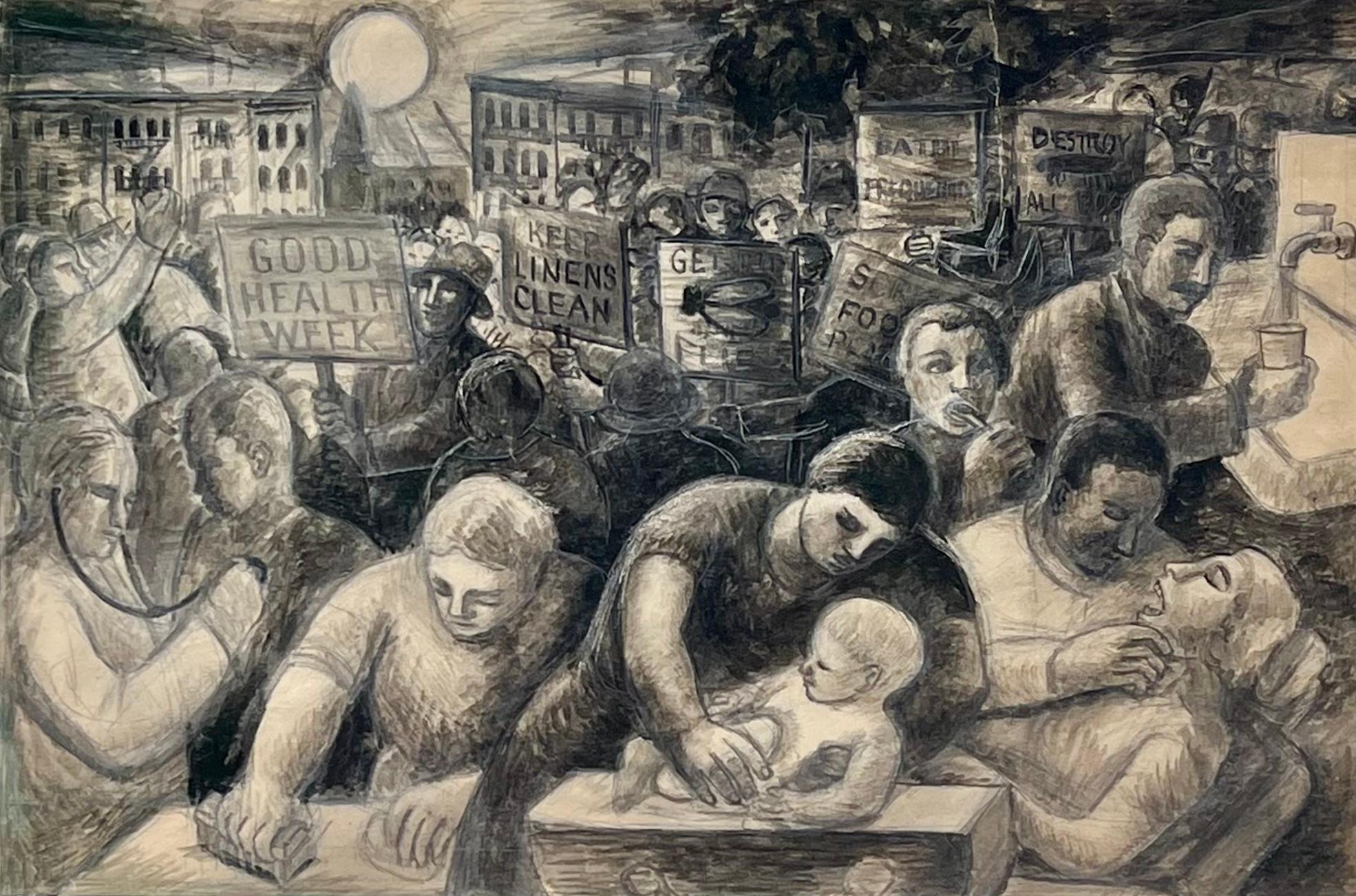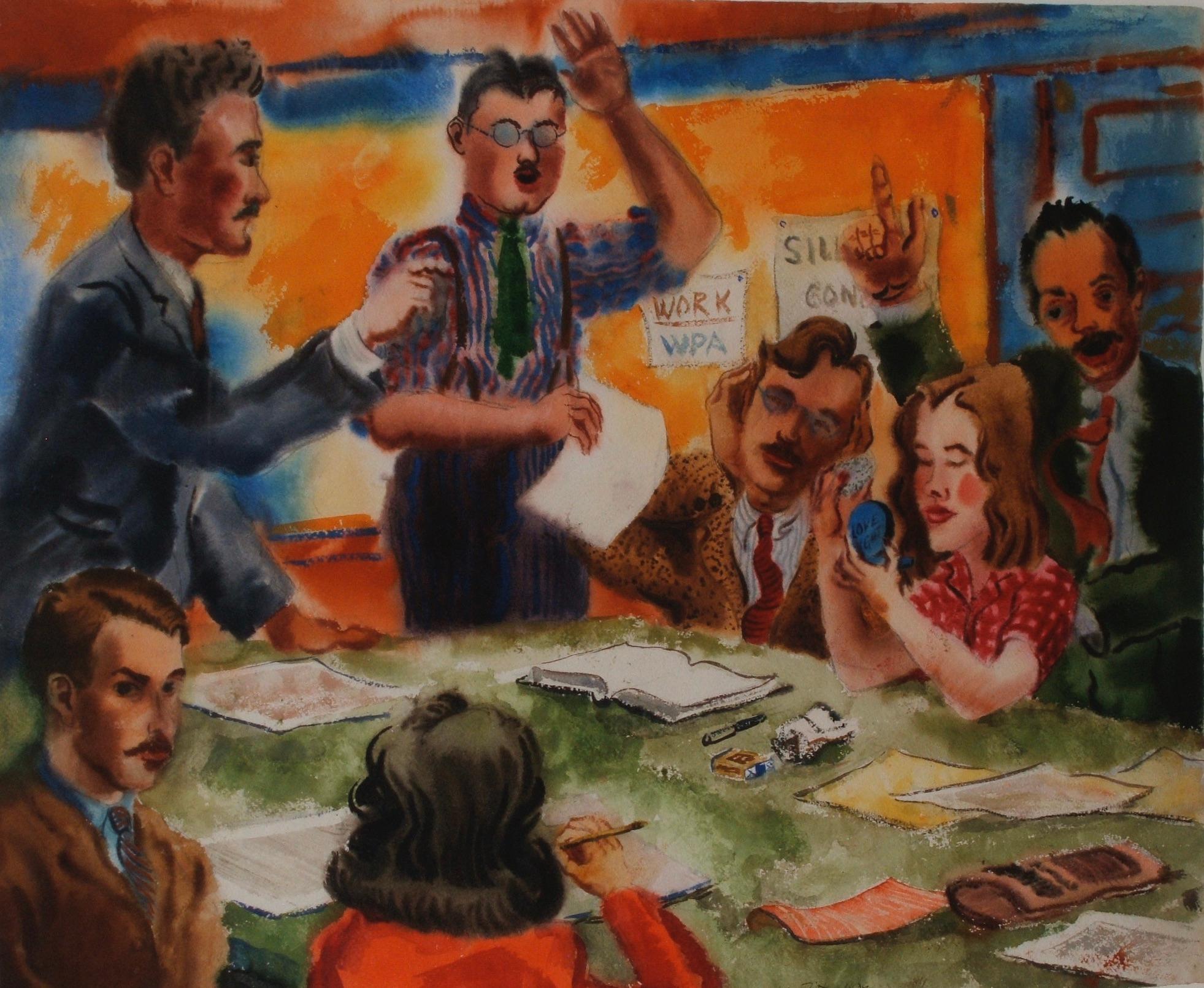Items Similar to Mural Studies, Palace of Fine Arts San Francisco WPA American Modernism 1930s
Want more images or videos?
Request additional images or videos from the seller
1 of 9
Frank Van SlounMural Studies, Palace of Fine Arts San Francisco WPA American Modernism 1930sc. 1936
c. 1936
About the Item
Mural Studies, Palace of Fine Arts San Francisco WPA American Modernism 1930s. 9 x 12 inches. Tempera on paper, c. 1936. Authenticated and signed verso by the artist’s sister, Katherine Van Sloun Fortune.
A painter, muralist, etcher and educator, Frank Van Sloun, living in San Francisco, became especially noted for his murals and for being the principal West Coast exponent of Social Realism. Described as being a painter of "contemporary, raw, hearty figure pieces and urban scenes" (Gerdts 282), Van Sloun learned about Social Realism in New York City under the tutelage of Robert Henri and other members of the Ashcan School.
During his career, Van Sloun experimented with a variety of styles and mediums including Impressionism, Realism, Pointillism and pastel, oil, tempera, watercolor, gouache, monotypes and etchings. The artist was also highly respected for his teaching abilities, and is credited with bringing the credo "art for art's sake" of his mentor, Robert Henri, to the Bay Area where Van Sloun, like Henri in New York, encouraged students to follow their own inclinations and not copy-cat his methods and subjects.
Frank Van Sloun was born in 1879 in St. Paul, Minnesota, where he attended grammar and high schools and from an early age, showed obvious talent and dedication to both art and sports. He studied at the St. Paul School of Fine Arts, and one of his influential painting teachers there was Ebenezer Comins. After two years, succumbing to his love of sports, he signed on with the St. Paul professional baseball team. However, he quickly did another turn around, and at age 22, enrolled in art classes at the Art Students League in New York City. For four years, he studied with painter and teacher Robert Henri, who was promoting Social Realists subjects of of everyday people going about their ordinary, less-than-glamourous lives. He also studied at the Chase School of Art, established by William Merritt Chase.
In New York, Frank Van Sloun joined the Society of Independent Artists, a group rebelling against the conservative trends of the National Academy of Design. In 1910, he helped Henri and other modernist artists organize the first exhibition of the Society.
Between 1907 and 1908 Van Sloun spent six months in San Francisco, California, his first visit to that state, and by 1911, he had established a studio there. He taught drawing, illustration and composition at the California School of the Fine Arts in 1917, and exhibited his work at the San Francisco Art Association's Fifty-Fifth Annual Exhibition. In 1926, he joined the faculty of the University of California, Berkeley and maintained a home studio at 1617 California Street. He also maintained his ties with New York City, and spent the year of 1919 teaching at the Art Students League.
In 1914 Frank Van Sloun received his first mural commission, which was for the Mayor's office in the city of Oakland, California. The two-part mural decoration depicted the scene of a pioneer family. He continued painting on canvas, and in 1915 was awarded a bronze medal at the Panama-Pacific International Exposition in San Francisco. His first solo exhibition was held the following year at the Helgesen Gallery in San Francisco.
He was an active contributor to the Bohemian Club of San Francisco and was elected to their board of directors in 1922. He painted many murals for the club, enhancing the walls and over-mantels of its interior. In 1926 he partnered with Maynard Dixon on a set of commissioned murals for the Mark Hopkins Hotel in San Francisco. The nine panels in "The Room of the Dons" showed the history of California and, an installation that took nine months to complete.
Van Sloun continued to paint murals for various California institutions including the California War Memorial Library building in Sacramento (1928); and the Greek inspired decorations for the Palace of Fine Arts in San Francisco (1936). He believed that his more minor works such as easel paintings, etchings and monotypes were just preparations for the larger mural paintings that would be on view to the public. He was more concerned with public approval for his murals than critical acclaim for his smaller works.
While preparing murals for the Golden Gate International Exposition of 1939 -1940, Frank Van Sloun died on August 27, 1938.
Memberships in California included the San Francisco Art Association, the Carmel Art Association, Bohemian Club, Society of Mural Painters and the California Society of Etchers.
- Creator:Frank Van Sloun (1879 - 1938, American)
- Creation Year:c. 1936
- Dimensions:Height: 21 in (53.34 cm)Width: 25 in (63.5 cm)Depth: 1 in (2.54 cm)
- Medium:Paper,Egg Tempera
- Movement & Style:
- Period:
- Condition:
- Gallery Location:New York, NY
- Reference Number:1stDibs: LU115629027732
About the Seller
5.0
Gold Seller
These expertly vetted sellers are highly rated and consistently exceed customer expectations.
Established in 2008
1stDibs seller since 2019
165 sales on 1stDibs
Typical response time: <1 hour
- ShippingRetrieving quote...Ships From: Pawling, NY
- Return PolicyA return for this item may be initiated within 3 days of delivery.
More From This SellerView All
- "The Knockout" Boxing Sports American Watercolor WPA Mid-Century Modern 30s/40sBy Robert RiggsLocated in New York, NY"The Knockout" Boxing Sports American Watercolor WPA Mid-Century Modern 30s/40s. Known for his paintings of prize-fighting and circus-genre scenes and lithography of gigantic size c...Category
1930s American Modern Figurative Drawings and Watercolors
MaterialsPaper, Watercolor
- "Good Health Week" American Scene Modern Social Realism Double Sided WPA EraBy Jo CainLocated in New York, NY"Good Health Week" American Scene Modern Social Realism Double Sided WPA Era Jo Cain (1904 - 2003) Good Health Week – double sided 13 3/4 x 20 1/2 in...Category
1930s American Modern Figurative Drawings and Watercolors
MaterialsInk, Paper, Gouache
- "Animated Discourse" WPA Mid-Century American Scene Modernism Realism FigurativeLocated in New York, NY"Animated Discourse" WPA Mid-Century American Scene Modernism Realism Figurative. Chris Ritter (American, 1906 – 1976) "Animated Discourse," 19 x 24 (sight). Watercolor on paper. Si...Category
1940s American Modern Figurative Drawings and Watercolors
MaterialsPaper, Watercolor
- Fortune Magazine cover Depression-Era Illustration, WPA industrial ModernistBy Ernest Hamlin BakerLocated in New York, NYFortune Magazine cover, Depression-Era Illustration, WPA industrial Modernist. Signed lower left. The drawing measures 13. x 11 inches. Framed by Bark...Category
1930s American Modern Interior Drawings and Watercolors
MaterialsGouache, Ink, Board
- "Steel Factory" Cuban Mid 20th Century Modern Drawing WPA Latin Art IndustrialLocated in New York, NY"Steel Factory" Cuban Mid 20th Century Modern Drawing WPA Latin Art Industrial Ink on paper. 12 x 19 inches. Pogolotti lived in Paris in the 1930s. The drawing here comes from the collection of his Parisian ophthalmologist, Dr. Prokopenko . Unfortunately, the artist lost his eyesight in 1938. Marcelo Pogolotti (1902–1988) was a Cuban painter...Category
1930s Modern Figurative Drawings and Watercolors
MaterialsPaper, Ink
- Deco Dancing Hungarian Expressionism European Drawing Modernism Figurative DanceBy Hugó ScheiberLocated in New York, NYDeco Dancing Hungarian Expressionism European Drawing Modernism Figurative Dance. 22 1/2 x 16 inches. Signed lower left. Framed. BIO Hugó Scheiber was born in Budapest in 1873. At the age of eight, he moved with his family from Budapest to Vienna. In 1898, to help support his family after they had returned to Budapest. He started working during the day, attending painting classes at the Commercial Art School in the evening. In 1900, he completed his studies. Scheiber showed an early interest in German Expressionism and Futurism. In 1915 he met Marinetti, who invited him to join the Futurist movement. Because Scheiber's paintings conflicted with academic style of the Hungarian art establishment, his work was virtually ignored in his own country. In 1919, he and his friend Béla Kádár held an exhibition organized by Hévesy in Vienna, which was a great success, so much so that the Budapest Art Museum purchased two of his drawings. In 1920, Scheiber returned to Vienna. A turning point in his career came in 1921 when Herwarth Walden, founder of Germany's leading avant-garde periodical, Der Sturm...Category
1920s Art Deco Figurative Drawings and Watercolors
MaterialsGouache, Paper
You May Also Like
- gravesend, oler woman w city scape window yellow tonesBy Stephen BassoLocated in Brooklyn, NYPastel on toned paper *ABOUT Stephen Basso Stephen Basso's highly original pastels and oil paintings are romantic, yet thought provoking fantasies. His whimsical works are alive ...Category
2010s American Modern Interior Drawings and Watercolors
MaterialsPaper, Pastel
- The VoyeurLocated in San Francisco, CAThis artwork "The Voyeur" c.1980 is a watercolor on heavy watercolor paper by California artist Charlotte Huntley. It is signed at the lower left cor...Category
Late 20th Century American Modern Interior Drawings and Watercolors
MaterialsWatercolor
- (Wounded Soldiers)Located in New York, NYWhile this is a World War II drawing, the barbed wire recalls the tranches of the First World War. A menacing tank at the upper left dominates the scene. There is a black border and...Category
Mid-20th Century American Modern Figurative Drawings and Watercolors
MaterialsGouache
- Emil Ganso, (Reclining Nude)By Emil GansoLocated in New York, NYA classic Emil Ganso nude. Quite large, the sheet is 14 1/8 x 21 inches and the image goes all the way across the sheet from left to right. Very delicately drawn - especially for Ganso.Category
1930s American Modern Figurative Drawings and Watercolors
MaterialsPencil
- The Catch - Original Drawing by Celestin Deshayes - Mid-19th CenturyLocated in Roma, ITThe Catch is an original artwork, gouache, tempera and watercolor realized by Celestin Deshayes (1817 -1896) . Hand signed on the lower right. Is not dated but we can attribute the p...Category
Mid-19th Century Modern Figurative Drawings and Watercolors
MaterialsGouache, Watercolor, Tempera
- Family on the Table - Tempera on Cardboard by Fabio Carriba - 1966Located in Roma, ITFamily on the Table is an original painting in tempera on cardboard realized by Fabio Carriba in 1966. Hand-signed on the lower right. In good condition. The artwork represents a...Category
1960s Figurative Drawings and Watercolors
MaterialsTempera, Cardboard
Recently Viewed
View AllMore Ways To Browse
San Francisco Gallery
Fine Arts Included
San Francisco Vintage Art
Contemporary Art Gallery San Francisco
San Francisco School
San Francisco City Painting
Early San Francisco
Canvas Mural
Paintings Of Palaces
C Francisco
Large Mural Art
Mural Studies
Mural Study
Large Mural Paintings
San Francisco Views
American Modernism
San Francisco Wall Art
San Francisco Street Sign


